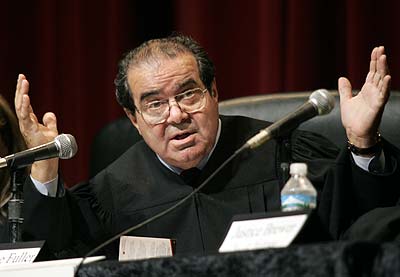US Supreme Court Threatens Speed Camera Industry
Red light camera and speed camera manufacturers fear that last month’s US Supreme Court ruling in the case Melendez-Diaz v. Massachusetts could create legal turmoil for the industry. The National Campaign to Stop Red Light Running issued a statement yesterday warning that the ruling has armed motorists with a greater ability to challenge the basis of automated traffic citations. Speed cameras, for example, depend heavily on legal faith in a certificate that claims to confirm the total reliability of a machine’s speed reading. In the Melendez-Diaz case, the high court ruled that merely producing such a certificate in court is insufficient. Defendants have the right to cross-examine any individual who claims to have certified evidence.
“Violators often object that they cannot challenge their accuser if it is a camera,” Leslie Blakey, executive director of the National Campaign to Stop Red Light Running said. “This new ruling may spur more court cases and lawsuits on the basis of the right to challenge the human elements of the evidentiary chain.”
Blakey is principal of the Blakey and Agnew public relations firm that five of the top photo enforcement companies — Affiliated Computer Services (ACS), CMA Consulting, Gatso of the Netherlands, Lasercraft of the UK and Redflex of Australia — paid to create the National Campaign to lobby on their behalf. Each of these firms could face a tremendous challenge if their methods are brought into closer scrutiny, although Blakey believes that this constitutional protections may not apply in states where photo tickets have been made “civil” violations.
Justice Antonin Scalia wrote the majority opinion in Melendez-Diaz, a 5-4 case that dealt with a laboratory analysis of drug evidence. The defendant argued that he had a right to question the lab worker who signed a piece of paper that certified the substance he had been carrying was cocaine. The majority agreed that despite the possible hassle involved in confirming each fact at trial, it is essential to the integrity of the court system that questioning of the evidence be allowed.
“The ‘certificates’ are functionally identical to live, in-court testimony, doing precisely what a witness does on direct examination,” Scalia wrote. “Respondent and the dissent may be right that there are other ways — and in some cases better ways — to challenge or verify the results of a forensic test. But the Constitution guarantees one way: confrontation. We do not have license to suspend the Confrontation Clause when a preferable trial strategy is available.”
Scalia further argued that the ability to confront witnesses is essential to ensuring that the potential for bias or error in scientific testing is uncovered.
“Nor is it evident that what respondent calls ‘neutral scientific testing’ is as neutral or as reliable as respondent suggests,” Scalia wrote. “Forensic evidence is not uniquely immune from the risk of manipulation…. And because forensic scientists often are driven in their work by a need to answer a particular question related to the issues of a particular case, they sometimes face pressure to sacrifice appropriate methodology for the sake of expediency. A forensic analyst responding to a request from a law enforcement official may feel pressure — or have an incentive — to alter the evidence in a manner favorable to the prosecution… the prospect of confrontation will deter fraudulent analysis in the first place.”
These concerns are especially apt with respect to the photo enforcement industry. In April, for example, lawmakers in France began to raise questions after learning that the private, for-profit company that operates the speed cameras, Sagem, is solely responsible for calibrating the units and certifying their accuracy. The situation is the same in the US, where companies that are in most cases paid on a per-ticket basis, are solely responsible for determining the accuracy of their own machines.
Under the ruling, it becomes the burden of the state or local authority to ensure photo enforcement company employees show up to testify in court. Failure to testify would result in the evidence being excluded and a likely acquittal.
“We’re concerned about the potential impact of this ruling on photo enforcement programs across the country,” Blakey said. “We don’t want to see anything jeopardize the public safety benefit of automated enforcement.”
A copy of the supreme court decision is available in a 350k PDF file at the source link below.
Melendez-Diaz v. Massachusetts (Supreme Court of the United States, 6/25/2009)
More by The Newspaper
Latest Car Reviews
Read moreLatest Product Reviews
Read moreRecent Comments
- ToolGuy TG likes price reductions.
- ToolGuy I could go for a Mustang with a Subaru powertrain. (Maybe some additional ground clearance.)
- ToolGuy Does Tim Healey care about TTAC? 😉
- ToolGuy I am slashing my food budget by 1%.
- ToolGuy TG grows skeptical about his government protecting him from bad decisions.


































Comments
Join the conversation
Scalia has been very consistent about the Confrontation Clause - there's no "substitute" for it is his basic position and has been the Court's position. This case is a singular example of why we should demand that Sotomayer NOT be confirmed to the Supreme Court, and that any Senator voting for her should not be getting our vote at election time, no matter what else that person does. The concept underlying all of this isn't so much a distrust of government as it is a trust of the individual juror. The notion that the jury is the best bs detector ever invented is also one to which Scalia vigorously subscribes. It should be instructive, of course, to remember that Obama has specifically said he would not appoint to the Supreme Court judges like Scalia. Another reason to hope and pray that Obama is a one term pretend president.